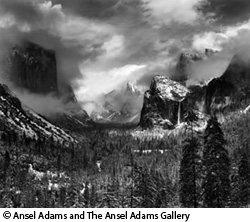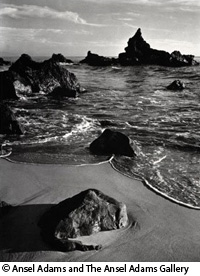





Black & White Luminaries: Insights into Adams and Garrett
Written By: SUSANNE LOMATCH
PAGE 2....
 Of some debate is Adams’ meaning in his "photographic visualization" hypothesis. From
his writings, it appears that he focused foremost on composition, with everything else
(including whether the shot was taken ‘perfectly’) secondary.
Of some debate is Adams’ meaning in his "photographic visualization" hypothesis. From
his writings, it appears that he focused foremost on composition, with everything else
(including whether the shot was taken ‘perfectly’) secondary.
Of "Clearing Winter
Storm" Adams remarked, "a certain amount of dodging and burning was required to
achieve the tonal balance demanded of my visualization…I think of a negative as the
‘score’ and the print as a ‘performance’ of that score, which conveys the emotional and
aesthetic ideas of the photographer at the time of making the exposure…there is no such
thing as the ideal or perfect negative [1]." Adams goes on to say of this (IMHO
technically perfect print) composition, "Although this photograph is often seen as an
environmental statement, I do not recall that I ever intentionally made a photograph for
environmentally significant purposes…my photographs that are considered to relate to
these issues are images conceived for their intrinsic aesthetic and emotional qualities,
whatever these may be [1]." Was Adams an artist first, and a photographer and
environmentalist second and third? His own words indicate so.
 "Rock and Surf (c1951)" is another striking composition that I could perhaps stare or
glance at for hours. Clearly it falls within Adams’ own description as aesthetic or
emotional, as he chose to highlight it in his portfolio even though it would surely garner
much technical criticism from photography perfectionists for its less-than-perfect shadow
content in the rock shadows. However, there are many valid artistic interpretations; the
lack of shadow content conveys a mysterious and dramatic sensation. Intriguingly,
Adams’ remarks for this photograph include: "I am well aware of a compelling impulse
of photographers to discuss, with collector’s dedication, the equipment and materials they
and their colleagues use, down to the smallest detail. I have never known painters to
debate with such intensity the kind of canvas, paper, brushes, and paints used in their
creative work. With photographers, however, such knowledge is traded in a kind of inner
language of arcane significance…I find myself wondering at times just how Edward
Weston made some of his photographs (he talked little of means and methods – it was
mostly empirical magic to him) [1]."
"Rock and Surf (c1951)" is another striking composition that I could perhaps stare or
glance at for hours. Clearly it falls within Adams’ own description as aesthetic or
emotional, as he chose to highlight it in his portfolio even though it would surely garner
much technical criticism from photography perfectionists for its less-than-perfect shadow
content in the rock shadows. However, there are many valid artistic interpretations; the
lack of shadow content conveys a mysterious and dramatic sensation. Intriguingly,
Adams’ remarks for this photograph include: "I am well aware of a compelling impulse
of photographers to discuss, with collector’s dedication, the equipment and materials they
and their colleagues use, down to the smallest detail. I have never known painters to
debate with such intensity the kind of canvas, paper, brushes, and paints used in their
creative work. With photographers, however, such knowledge is traded in a kind of inner
language of arcane significance…I find myself wondering at times just how Edward
Weston made some of his photographs (he talked little of means and methods – it was
mostly empirical magic to him) [1]."